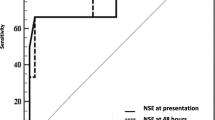Abstract
Stroke is the third major cause of death and foremost cause of disability worldwide. Cerebrovascular stroke remains largely a clinical diagnosis. The use of biomarkers in diagnosing stroke and assessing prognosis is an emerging and rapidly evolving field. The study aimed to investigate the predictive value of neurobiochemical marker of brain damage (neuron-specific enolase [NSE]) with respect to degree of disability at the time of admission and neurological worsening in acute ischemic stroke patients. We investigated 150 patients with cerebrovascular stroke who were admitted within 72 h of onset of stroke in the Department of Neurology at SAIMS. Venous blood samples were taken after admission and NSE was analyzed by solid enzyme linked immunosorbent assay using Analyzer and microplate reader from Biored: Code 680. In all patients, the neurological status was evaluated by a standardized neurological examination and the National Institutes of Health Stroke Scale on admission and on day 7. Serum NSE concentration was found to significantly correlate with both degree of disability and neurological worsening in acute ischemic stroke cases in the present study. The maximum serum NSE level within 72 h of admission was significantly higher in patients with greater degree of disability at the time of admission. Serum NSE levels were also found to be significantly elevated in patients with bad neurological outcome. Our study showed that serum NSE has high predictive value for determining severity and early neurobehavioral outcome after acute stroke.

Similar content being viewed by others
References
Marangos PJ. Neuron specific enolase: a clinically useful marker of neurons and neuroendocrine cells. Annu Rev Neurosci. 1987;10:269–95.
Barone FC, Clark RK, Price WJ, White RF, Feuerstein GZ, Storer BL, Ohlstein EH. Neuron-specific enolase increases in cerebral and systemic circulation following focal ischemia. Brain Res. 1993;623:77–82.
Butterworth RJ, Wassif WS, Sherwood RA, Gerges A, Poyser KH, Garthwaite J, Peters TJ, Bath PMW. Serum neuron-specific enolase, carnosinase, and their ratio in acute stroke. Stroke. 1996;27:2064–8.
Cunningham RT, Watt M, Winder J, McKinstry S, Lawson JT, Johnston CF, Hawkins SA, Buchanan KD. Serum neurone-specific enolase as an indicator of stroke volume. Eur J Clin Invest. 1996;26:298–303.
Hårdemark HG, Ericsson N, Kotwica Z, Rundströ G, Mendel-Hartvig I, Olsson Y, Påhlman S, Persson L. S-100 protein and neuron-specific enolase in CSF after experimental traumatic or focal ischemic brain damage. J Neurosurg. 1989;71:727–31.
Hatfield RH, McKernan RM. CSF neuron-specific enolase as a quantitative marker of neuronal damage in a rat model. Brain Res. 1992;577:249–52.
Horn M, Seger F, Schlote W. Neuron-specific enolase in gerbil brain and serum after transient cerebral ischemia. Stroke. 1995;26:290–7.
Casmiro M, Maitan S, De Pasquale F. Cerebrospinal fluid and serum neuron-specific enolase concentrations in a normal population. Eur J Neurol. 2005;12(5):369–74.
Kwan J. Hand P Early neurological deterioration in acute stroke: clinical characteristics and impact on outcome. QJM. 2006;99:625–33.
Fassbender K, Schmidt R, Schreiner A, et al. Leakage of brain-originated proteins in peripheral blood: temporal profile and diagnostic value in early ischemic stroke. J Neurol Sci. 1997;148(1):101–5.
Anand N, Stead LG. Neuron-specific enolase as a marker for acute ischemic stroke: a systematic review. Cerebrovasc Dis. 2005;20(4):213–9.
Stevens H, Jakobs C, de Jager AE, Cunningham RT, Korf J. Neurone-specific enolase and N-acetyl-aspartate as potential peripheral markers of ischaemic stroke. Eur J Clin Invest. 1999;29:6–11.
Hill MD, Jackowski G, Bayer N, Lawrence M, Jaeschke R. Biochemical markers in acute ischemic stroke. CMAJ. 2000;162:1139–40.
Schaarschmidt H, Prange HW, Reiber H. Neuron-specific enolase concentrations in blood as a prognostic parameter in cerebrovascular disease. Stroke. 1994;25:558–65.
Wunderlich MT, Ebert AD, Kratz T, Goertler M, Jost S, Herrmann M. Early neurobehavioral outcome after stroke is related to release of neurobiochemical markers of brain damage. Stroke. 1999;30:1190–5.
Ferrarese C, Mascarucci P, Zoia C, Cavarretta R, Frigo M, Begni B. Increased cytokine release from peripheral blood cells after acute stroke. J Cereb Blood Flow Metab. 1999;19:1004–9.
Smith CJ, Emsley HCA, Gavin CM, et al. Peak plasma interleukin-6 and other peripheral markers of inflammation in the first week of ischemic stroke correlate with brain infarct volume, stroke severity and long-term outcome. BMC Neurol. 2004;4:2.
Missler U, Wiesmann M, Friedrich C, Kaps M. S-100 protein and neuron-specific enolase concentrations in blood as indicators of infarction volume and prognosis in acute ischemic stroke. Stroke. 1997;28:1956–60.
Acknowledgment
Reviewers are acknowledged in the January issue for the previous year.
Author information
Authors and Affiliations
Corresponding author
Rights and permissions
About this article
Cite this article
Bharosay, A., Bharosay, V.V., Varma, M. et al. Correlation of Brain Biomarker Neuron Specific Enolase (NSE) with Degree of Disability and Neurological Worsening in Cerebrovascular Stroke. Ind J Clin Biochem 27, 186–190 (2012). https://doi.org/10.1007/s12291-011-0172-9
Received:
Accepted:
Published:
Issue Date:
DOI: https://doi.org/10.1007/s12291-011-0172-9




